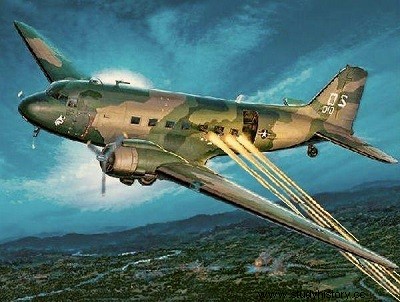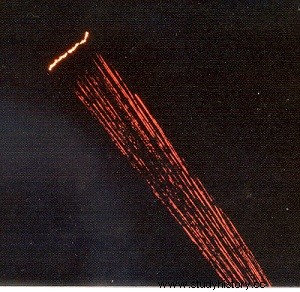
The RC-47 was not the only version of the extraordinary Dakota to be used in Vietnam, more than 30 years after the aircraft's first prototype flew. There was especially the AC - 47 attack, nicknamed "Puff, the Magic Dragon" (title of an American song). It carried very effective armament consisting of three 7.7 mm General Electric Minigun machine guns capable of firing 6,000 rounds per minute (the so-called "Gatling" system, after the machine gun used during the Civil War, with several swiveling tubes), and fed by huge ammunition strips extended in the cabin.
The AC47 intervened at night and often worked with a FAC scout or an aircraft equipped with detectors. As soon as the target was located, the pilot aligned it in line with his left wing thanks to the optical sight located on his left canopy. This engaged the aircraft in a sharp turn to the left. The area was then riddled with bullets; the AC-47 could sweep very wide angles of fire thanks to its flight position.
This seemingly crude technique proved to be formidable.
Other transport aircraft were quickly modified for this mission. Among the most successful conversions was the Fairchild AC119G, derived from the Korean War twin-boom transport, equipped with four Miniguns, a battery of very powerful searchlights, with an independent generator, a fire control system and protective shields. The AC-119K had increased propellant power (two booster jets), infrared detectors, radars and two 20 mm Vulcan cannons (also a “Gatling” system) firing at a rate of 4 to 6,000 rounds per minute. Even more effective was the Lockheed AC-130E Spectre, conversion of the Hercules with four Miniguns and four Vulcans, plus an unimaginable assortment of detectors, radars, etc. The Specter appeared in 1970; proof of its effectiveness, it survived the Vietnam War and the USAF today maintains a squadron of it.

